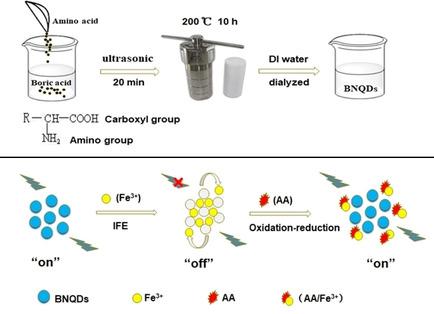当前位置:
X-MOL 学术
›
ChemistrySelect
›
论文详情
Our official English website, www.x-mol.net, welcomes your
feedback! (Note: you will need to create a separate account there.)
Amino Acids as the Nitrogen Source to Synthesize Boron Nitride Quantum Dots for Fluorescence Turn‐off‐on Detection of Ascorbic Acid
ChemistrySelect ( IF 1.9 ) Pub Date : 2020-04-01 , DOI: 10.1002/slct.202000602 Yuelin Kong 1 , Yu He 1 , Ji Zhou 1 , Shuhua Zhong 2 , Gongwu Song 1
ChemistrySelect ( IF 1.9 ) Pub Date : 2020-04-01 , DOI: 10.1002/slct.202000602 Yuelin Kong 1 , Yu He 1 , Ji Zhou 1 , Shuhua Zhong 2 , Gongwu Song 1
Affiliation

|
The BNQDs are synthesized by simple one‐step hydrothermal method, using amino acids as nitrogen source and boric acid as boron source. The BNQDs prepared by different amino acids emit strong blue fluorescence with the excitation wavelength from 280 to 400 nm. An “on‐off‐on” BNQDs fluorescent sensor is designed to detect ascorbic acid with Fe3+ as medium, extending the application in sensing. The fluorescence of BNQDs is quenched by Fe3+ on basis of the inner filter effect. With increasing of ascorbic acid, the fluorescence of BNQDs is recovered due to the oxidation‐reduction between Fe3+ and ascorbic acid. The assay is capable of recognizing ascorbic acid in the concentration range of 1–100 μM with a detection limit of 0.0833 μM. In addition, the method has the potential to determine Fe3+ and ascorbic acid in real water samples and human serum.
中文翻译:

氨基酸为氮源,用于合成氮化硼量子点,用于荧光关断检测抗坏血酸
BNQD是通过简单的一步水热法合成的,以氨基酸为氮源,硼酸为硼源。由不同氨基酸制备的BNQD发出强烈的蓝色荧光,激发波长为280至400 nm。“开-关” BNQDs荧光传感器旨在检测以Fe 3+为介质的抗坏血酸,从而扩展了其在传感领域的应用。BNQDs的荧光在内部滤光效应的基础上被Fe 3+淬灭。随着抗坏血酸的增加,由于Fe 3+之间的氧化还原,BNQDs的荧光得以恢复。和抗坏血酸。该方法能够识别浓度范围为1–100μM的抗坏血酸,检出限为0.0833μM。此外,该方法还可以测定真实水样和人血清中的Fe 3+和抗坏血酸。
更新日期:2020-04-01
中文翻译:

氨基酸为氮源,用于合成氮化硼量子点,用于荧光关断检测抗坏血酸
BNQD是通过简单的一步水热法合成的,以氨基酸为氮源,硼酸为硼源。由不同氨基酸制备的BNQD发出强烈的蓝色荧光,激发波长为280至400 nm。“开-关” BNQDs荧光传感器旨在检测以Fe 3+为介质的抗坏血酸,从而扩展了其在传感领域的应用。BNQDs的荧光在内部滤光效应的基础上被Fe 3+淬灭。随着抗坏血酸的增加,由于Fe 3+之间的氧化还原,BNQDs的荧光得以恢复。和抗坏血酸。该方法能够识别浓度范围为1–100μM的抗坏血酸,检出限为0.0833μM。此外,该方法还可以测定真实水样和人血清中的Fe 3+和抗坏血酸。









































 京公网安备 11010802027423号
京公网安备 11010802027423号